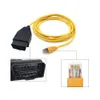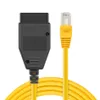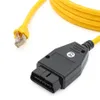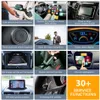The role of data transfer is crucial in BMW F-Series vehicles, as various systems and components rely on it for performance and maintenance. Reliable and fast data transfer is essential to ensure optimum vehicle performance. The ENET Cable offers a durable and long-lasting solution for data transfer that is user-friendly for both car owners and technicians. Compared to wireless methods, the ENET Cable is cost-effective and efficient, making it a more viable solution for data transfer needs. Overall, the ENET Cable is an ideal choice for those seeking reliable and efficient data transfer solutions for their BMW F-Series vehicles.








The role of data transfer in BMW F-Series vehicles
As technology continues to advance, more and more devices are relying on data transfer for their proper functioning. The automotive industry is no exception to this trend, as modern cars are equipped with an array of systems and components that require reliable and fast data transfer. BMW F-Series vehicles, in particular, rely heavily on data transfer to ensure optimal performance and maintenance.
The Various Systems and Components that Rely on Data Transfer in BMW F-Series Vehicles
Modern BMW F-Series vehicles are equipped with a plethora of systems and components that depend on data transfer. These include the infotainment system, the iDrive interface, the climate control system, the engine management system, and the transmission control system. Each of these systems requires data transfer to function properly.
The infotainment system in BMW F-Series vehicles includes features such as Bluetooth connectivity, satellite radio, and navigation. These features rely on data transfer to function properly. For instance, the navigation system relies on real-time traffic data to provide accurate directions to the driver. Similarly, the Bluetooth connectivity feature requires data transfer to enable hands-free calling and audio streaming.
Another important system in BMW F-Series vehicles that relies heavily on data transfer is the iDrive interface. This system allows the driver to control various functions of the car, such as the climate control system and the infotainment system, through a central display. The iDrive interface also displays important information about the car’s performance, such as fuel consumption and tire pressure. All of this information requires data transfer to be displayed accurately.
The climate control system in BMW F-Series vehicles is another example of a component that relies on data transfer. This system uses temperature and humidity sensors to automatically adjust the temperature and airflow inside the car. The sensors require data transfer to communicate with the climate control system’s computer and make adjustments accordingly.
The Importance of Reliable and Fast Data Transfer for Vehicle Performance and Maintenance
Reliable and fast data transfer is crucial for ensuring optimal performance and maintenance of BMW F-Series vehicles. Without it, the various systems and components mentioned above may not function properly, leading to decreased performance and potential safety hazards.
For instance, a slow or unreliable data transfer could cause delays or inaccuracies in the navigation system, potentially leading the driver down the wrong route or causing them to miss a turn. Inaccurate or delayed information from the engine management system could lead to decreased fuel efficiency and engine performance. And a malfunctioning climate control system could lead to discomfort for the passengers and potential safety hazards if visibility is compromised due to fogged-up windows.
In addition to performance concerns, reliable and fast data transfer is crucial for proper maintenance of BMW F-Series vehicles. Modern cars are equipped with advanced diagnostic systems that can detect potential issues before they become major problems. These systems rely on data transfer to communicate with the car’s computer and perform diagnostics. Without reliable and fast data transfer, these systems may not be able to detect issues in a timely manner, potentially leading to costly repairs down the line.
Benefits of using the ENET Cable for data transfer
One of the most significant advantages of using the ENET cable for data transfer is its durability. The cable can withstand extreme temperatures, wear and tear, and harsh conditions. This feature ensures that the cable lasts longer than any other cables available in the market. The ENET cable’s durability makes it ideal for long-term use, saving car owners and technicians money on frequent replacements.
Another perk of using the ENET cable is its user-friendly design, which makes it convenient for car owners and technicians to access the onboard computers of vehicles. Whether you are an experienced mechanic or a novice car owner, the simplicity of the ENET cable design makes it easy to connect to your vehicle. The user-friendly interface provides valuable feedback, such as identifying error codes that help diagnose and fix issues faster.
Car owners and technicians alike can appreciate the ease of use of the ENET cable. The cable’s plug-and-play feature eliminates the need for complex configurations, making it simple to install. Additionally, the ENET cable is compatible with various devices and operating systems. This compatibility means that users do not have to worry about purchasing additional cables or adapters when using different devices.
Comparing the ENET Cable with other data transfer methods
Firstly, let’s take a look at wireless data transfer methods such as Wi-Fi and Bluetooth. While these methods are convenient as they eliminate the need for cables, they come with their own set of limitations. Wi-Fi signals can be affected by interference from walls and other devices, resulting in slower speeds. On the other hand, Bluetooth has a limited range and can only transfer data between devices that are in close proximity to each other. As a result, if you need to transfer large amounts of data quickly and reliably, wireless data transfer methods may not be the most suitable option.
On the other hand, the ENET Cable provides a reliable and fast solution for data transfer. The cable connects devices through Ethernet ports, providing a stable connection with no interference or signal loss. Unlike wireless methods, the ENET Cable does not have a limit on range or bandwidth, meaning you can transfer large files quickly and effortlessly.
When it comes to cost-effectiveness and efficiency, the ENET Cable proves to be an excellent choice. While wireless transfer methods require additional hardware such as routers and adapters, the ENET Cable only requires a single cable to connect devices. This makes it more affordable and efficient than wireless alternatives.
Furthermore, the ENET Cable also offers improved security compared to wireless methods. Wireless signals can be intercepted by hackers and interfere with your network’s security. However, the ENET Cable provides a secure, wired connection that is difficult to intercept or hack.
In conclusion, while wireless data transfer methods may be convenient for everyday use, they might not be the most suitable option for heavy-duty data transfers. The ENET Cable provides a fast, reliable, and secure data transfer solution that is cost-effective and efficient. It is ideal for transferring large amounts of data quickly and without the risk of interference or loss of connectivity. If you’re looking for a reliable and efficient way to transfer data, the ENET Cable is undoubtedly the best choice for you.
FAQ
Q1. What is an ENET cable and how does it facilitate efficient data transfer for BMW F-Series vehicles?
The ENET cable is a specialized Ethernet to OBD2 interface cable that allows for high-speed data transfer between a computer or diagnostic tool and the OBD2 port in BMW F-Series vehicles. This enables users to quickly and securely access and modify vehicle data, such as coding and programming, without the need for a complicated and time-consuming setup.
Q2. How durable is the ENET cable and what makes it suitable for use with BMW F-Series vehicles?
The ENET cable is designed to be highly durable, featuring a rugged construction that can withstand the rigors of automotive use. It is constructed with high-quality materials and is built to endure frequent plugging and unplugging, making it ideal for use in professional automotive workshops and by DIY enthusiasts alike. Additionally, the ENET cable is specifically engineered to be compatible with the unique OBD2 port found in BMW F-Series vehicles, ensuring a secure and reliable connection every time.
Q3. Can the ENET cable be used by individuals with limited technical knowledge?
Yes, the ENET cable is designed to be user-friendly and accessible to individuals with varying levels of technical expertise. With its plug-and-play functionality, users can easily connect the cable to their BMW F-Series vehicle and a computer or diagnostic tool, without the need for complex configurations or additional software installation. Combined with comprehensive instructional resources and customer support, the ENET cable empowers users to efficiently perform tasks such as coding and programming without extensive technical know-how.
Q4. What are the key benefits of using the ENET cable for BMW F-Series vehicles?
The ENET cable offers several advantages for users working with BMW F-Series vehicles, including fast and reliable data transfer, durable construction for long-term usability, and intuitive plug-and-play functionality. By leveraging the ENET cable, users can streamline their diagnostic and programming workflows, saving time and effort while maintaining a high level of precision and control. Whether used by automotive professionals or enthusiasts, the ENET cable provides a valuable tool for unlocking the full potential of BMW F-Series vehicles.